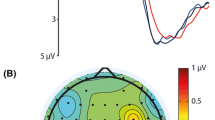Abstract
Visual event-related potentials were recorded from five male autistics and five matched controls. Sensory effects were investigated by having subjects passively view flashes of three different but equiprobable intensities (augmenting/reducing paradigm). Cognitive effects were examined by having subjects count infrequent, target, flashes of one intensity embedded within a series of frequent, nontarget, flashes of a different intensity (oddball paradigm). In the augmenting/reducing paradigm, the sensory N100 wave of autistic but not controls showed a significant increase in amplitude (augmenting) as flash intensity increased. The cognitive P300 wave of autistics did not differ from controls in the oddball paradigm. Unlike controls, autistics had an equally large P300 in the no-task augmenting/reducing paradigm. It is concluded that autistics may experience a degree of stimulus overload in the visual modality.
Similar content being viewed by others
References
American Psychiatric Association. (1980).Diagnostic and statistical manual of mental disorders (3rd ed.). Washington, D.C.: Author.
August, G. J., Raz, N., Papanicolaou, A. C., Baird, T. D., Hirsh, S. L., & Hsu, L. L. (1984). Fenfluramine treatment in infantile autism: Neurochemical, electrophysiological, and behavioral effects.Journal of Nervous and Mental Disease, 172, 604–612.
Barratt, E. S., Pritchard, W. S., Faulk, D. M., & Brandt, M. E. (1985). Visual N100 augmenting/reducing and impulsiveness.Psychophysiology, 22, 583.
Buchsbaum, M. S. (1976). Self-regulation of stimulus intensity. In G. E. Schwartz & D. Shapiro (Eds.),Consciousness and self-regulation. New York: Plenum Press.
Buchsbaum, M. S. (1978). Neurophysiological studies of reduction and augmentation. In A. Petrie (Ed.),Individuality in pain and suffering (2nd ed.), Chicago: University of Chicago Press.
Courchesne, E., Kilman, B. A., Galambos, R., & Lincoln, A. J. (1984). Autism: Processing of novel and auditory information assessed by event-related brain potentials.Electroencephalography and Clinical Neurophysiology, 59, 238–248.
Courchesne, E., Lincoln, A. J., Kilman, B. A., & Galambos (1985). Event-related brain potential correlates of the processing of novel visual and auditory information in autism.Journal of Autism and Developmental Disorders, 15, 55–76.
Damasio, A. R., & Maurer, R. G. (1978). A neurological model for childhood autism.Archives of Neurology, 35, 778–786.
Donchin, E., & Bashore, T. (in press). Clinical versus psychophysiological paradigm in the study of event-related potentials.Behavioral and Brain Sciences.
Duncan-Johnson, C. C., & Donchin, E. (1977). On quantifying surprise: The variation in eventrelated potentials with subjective probability.Psychophysiology, 14, 456–467.
Iacono, W. G., Gabbay, F. H., & Lykken, D. T. (1982). Measuring the average evoked response to light flashes: The contribution of eye-blink artifact to augmenting/reducing.Biological Psychiatry, 17, 897–911.
Niwa, S., Ohta, M., & Yamazaki, K. (1983). P300 and stimulus evaluation process in autistic subjects.Journal of Autism and Developmental Disorders, 13, 33–42.
Novick, B., Kurtzberg, D., & Vaughan, H. G., Jr. (1979). An electrophysiologic indication of defective information storage in childhood autism.Psychiatry Research, 1, 101–108.
Novick, B., Vaughan, H. G., Jr., Kurtzberg, D., & Simson, R., (1980). An electrophysiologic indication of auditory processing defects in autism.Psychiatry Research, 3, 107–114.
Ornitz, E. M. (1983). The functional neuroanatomy of infantile autism.International Journal of Neuroscience, 19, 85–124.
Pritchard, W. S. (1981). Psychophysiology of P300.Psychological Bulletin, 89, 506–540.
Pritchard, W. S. (1986). Cognitive event-related potential correlates of schizophrenia.Psychological Bulletin, 100, 43–66.
Pritchard, W. S., Brandt, M. E., O'Dell, T. J., Shappell, S. A., & Barratt, E. S. (1985). Individual differences in visual event-related potentials: P300 cognitive augmenting/reducing parallels N100 sensory augmenting/reducing.International Journal of Psychophysiology, 3, 49–56.
Pritchard, W. S., Raz, N., & August, G. J.International Journal of Neuroscience, in press.
Ritvo, E. R., & Freeman, B. J. (1977). National Society for Autistic Children definition of the syndrome of autism.Journal of Pediatric Psychiatry, 2, 142–145.
Saitoh, O., Niwa, S., Hiramatsum, K., Kameyama, T., Rymar, K., & Itoh, K. (1984). Abnormalities in late positive components of event-related potentials may reflect a genetic predisposition to schizophrenia.Biological Psychiatry, 19, 293–303.
Satterfield, J. H., & Schell, A. M. (1984). Childhood brain function differences in delinquent and non-delinquent hyperactive boys.Electoencephalography and Clinical Neurophysiology, 57, 199–207.
Sherman, M., Nass, R., & Shapiro, T. (1984). Brief report: Regional cerebral blood flow in autism.Journal of Autism and Developmental Disorders, 14, 439–446.
Small, J. G. (1975). EEG and neurophysiological studies of early infantile autism.Biological Psychiatry, 10, 385–397.
Strandburg, R. J., Marsh, J. T., Brown, W. S., Asarnow, R. F., & Guthrie, D. (1984). Eventrelated potential concomitants of information processing dysfunction in schizophrenic children.Electroencephalography and Clinical Neurophysiology, 57, 236–253.
Vaughan, H. G., Jr. (1974). The analysis of scalp-recorded brain potentials. In R. F. Thompson & M. M. Patterson (Eds.),Bioelectric recording techniques, Part B. Electroencephalography and human brain potentials. New York: Academic Press.
Author information
Authors and Affiliations
Rights and permissions
About this article
Cite this article
Pritchard, W.S., Raz, N. & August, G.J. Visual augmenting/reducing and P300 in autistic children. J Autism Dev Disord 17, 231–242 (1987). https://doi.org/10.1007/BF01495058
Issue Date:
DOI: https://doi.org/10.1007/BF01495058




